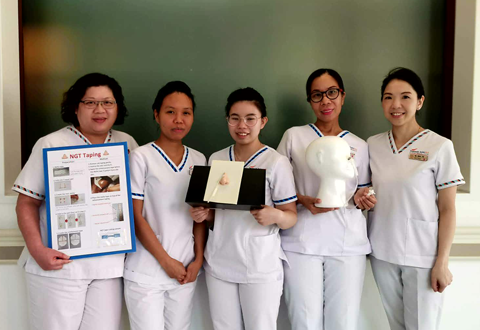
Team Revivors from CTICU, Ward 56 and Ward 44 – Coronary Care Unit standardised the type of tape and taping method in securing the patient's nasal gastric tube to effectively cut medical-device related nasal pressure injuries to zero.
Do you know it takes almost an extra half an hour to care for a patient with nasal skin injury arising from a change of their nasal gastric (NG) tube tape?
An NG tube is a long, thin polyurethane, silicone or rubber tube that is inserted into the patient’s nasal passage to administer or remove substances in the stomach. While this is standard procedure for patients who are intubated, critically ill or unable to ingest orally, have you ever stopped to take a closer look at how the tube is secured to the nose?
“We realised that not only was there no standardised type of tape securing the tube to the patient’s nose, the method of securing the tape also differs,” shared Nurse Clinician (NC) Mirana Wu from the Cardiothoracic Intensive Care Unit (CTICU). This was the main reason the number of medical device-related nasal pressure injury incidences soared from five to 12 from January 2017 to December 2018 and the driving force behind the formation of a quality improvement team to look into the issue.
A knotty issue
The team discovered that a variety of tapes were being used to secure the tube – from silk, micropore to brown tape. The way the tape was anchored to the tube and patient’s nose also depends on the staff attending to the patient.

The type of tape used and the method used to secure the tube varied. (Anti-clockwise from top left): Micropore tape versus brown tape; nasal skin injury.
“At times, the tape became so knotted and difficulty to remove, the patient’s skin tears as a result,” said team leader NC Mirana. A nasal injury could result in patients requiring additional treatment or getting potential infection. In a worst-case scenario, patients may require plastic surgery and could potentially lead to self-esteem issues in patients. The team acknowledged that there was an urgent need to standardise the process.
A hinge towards safety
“In terms of effectiveness, value for money, sensitivity to skin and ease of availability on the market, fabric tape tops in our evaluation of different tape materials. A trial on 50 patients also affirmed that fabric tape was non-sticky yet adheres well on patient’s skin and feels more comfortable during removal,” said Assistant Nurse Clinician (ANC) Sazali Bin Arif from CTICU and project co-leader.

Hinge-taping gave free allowance between the nares of the nose and the NG tube, reducing the pressure and risk of nasal injury.
The team also researched extensively on the taping method, “We were inspired by the shape of the nasal strip that’s currently in the market. The hinge-like shape was found to be effective and writing the date that the tape was changed on the tape directly also ensures that they are changed daily.”
To enforce the new practice, education was key. Nurses were taught the new standardised method with bedside teaching and supervision to ensure the right technique was used. Posters detailing the new method were also installed at all nursing stations to serve as a visual cue.
Results were immediate, “There has been no incidences since we implemented the new tape and taping method. With nearly 10 hours saved per annum to manage such injuries, our nurses can focus on patients who need more care.”













 Get it on Google Play
Get it on Google Play